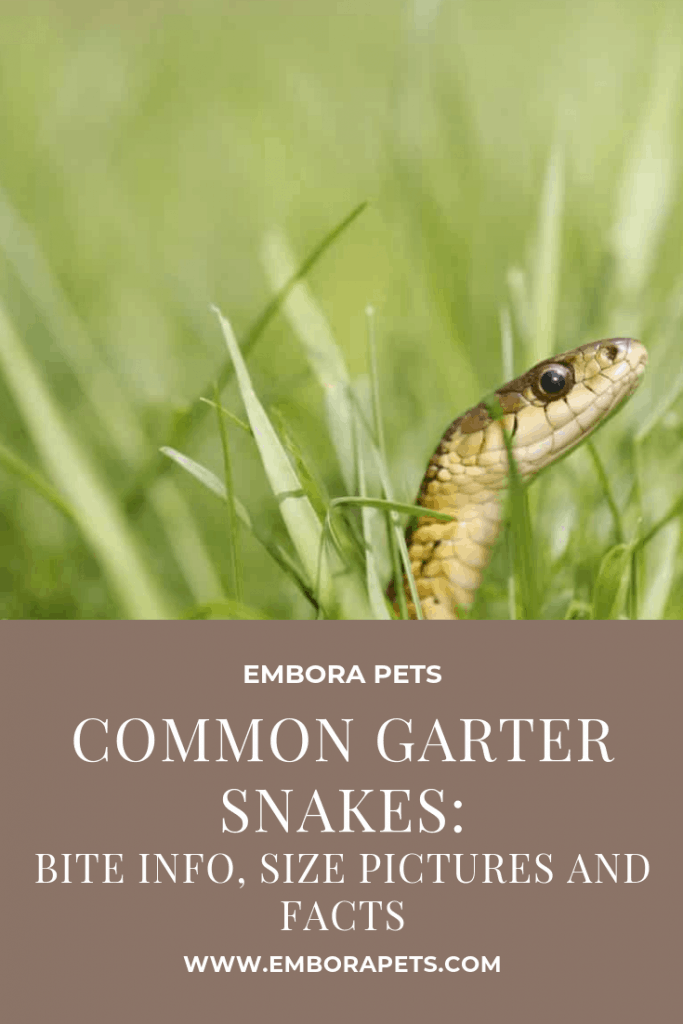Common Garter Snakes: Size, Bite Information, Pictures, and Facts
Garter snakes, while small in size, have been quite full of discoveries. I did a little research so I can tell you all about them.
What’s so cool about common garter snakes? Garter snakes are some of the most prevalent snakes in North America, especially in the US. These snakes are relatively small as they only grow to an average of 23 to 30 inches.
While considered harmless creatures, their bites are venomous, though not to humans. Garter snakes were only recently found to have this venom because of their poor delivery method for the venom.
With all of this to cover and more, continue reading as we explore one of America’s most common snakes: the garter snake.
How to Identify a Garter Snake
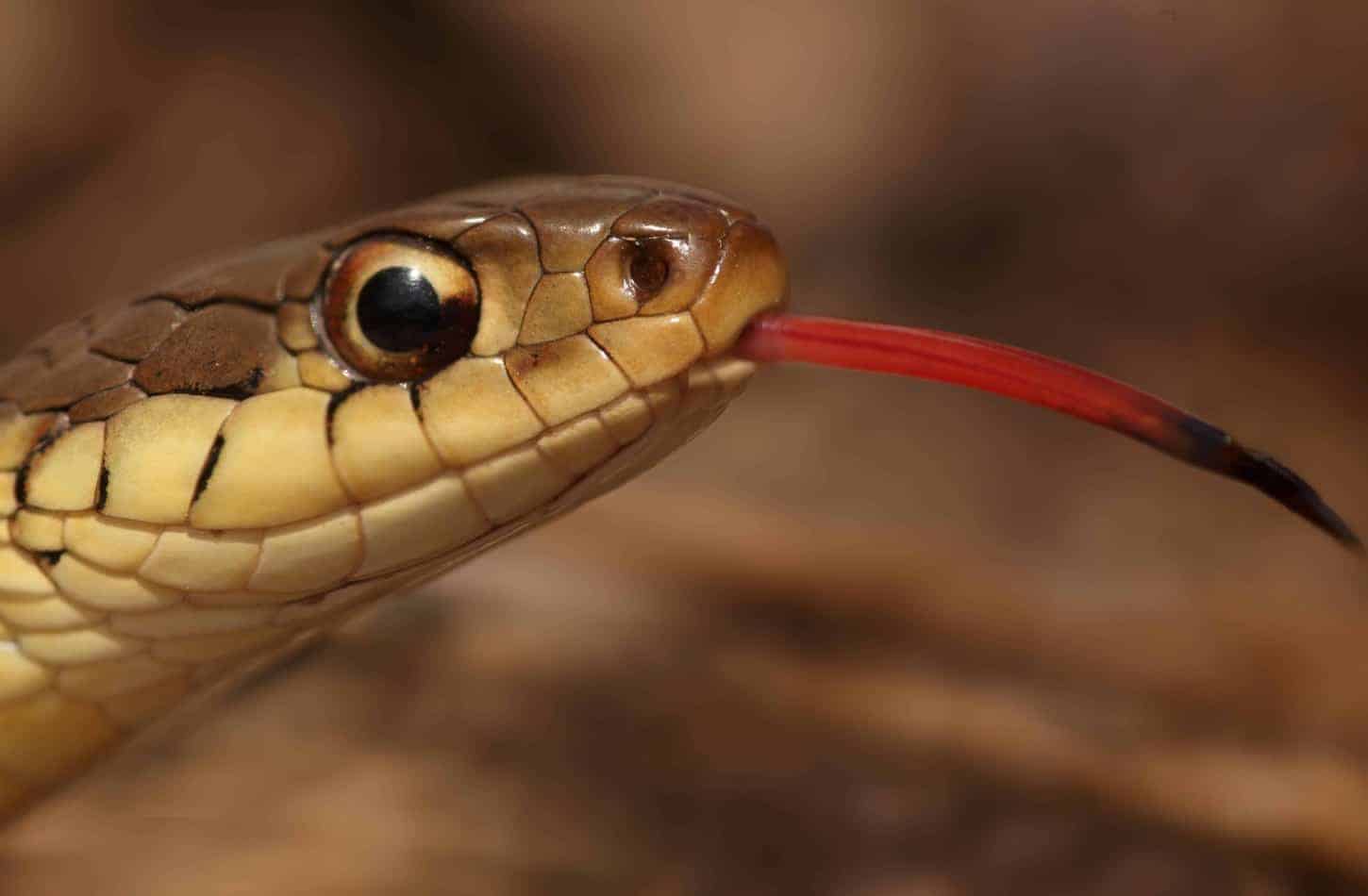
Garter snakes are small, common snakes that many people keep as pets but are widely found in the wild as well. They range from about 23 inches to about 30 inches, making them easy to handle and unable to cause much damage to a human.
But aside from size, how can you determine if you are looking at a garter snake? Garter snakes come in various colors often black or brown, though red, green, and other colors are possible as well. However, a common feature among them are the stripes down their backs. Typically, these stripes will be a kind of yellow color, but it can vary a bit.
Though most garter snakes have these stripes in their patterns, some garter snakes have almost no stripes and some have a checkered pattern instead of stripes. The bellies of garter snakes are often lighter than the rest of the body.
Garter snakes have small heads that come to a small rounded nose at the front. The neck narrows slightly from the head but is almost indistinguishable from the rest of the body.
If you are close enough to a garter snake to look at its eyes, you should see that they are likely a yellowish-gold color and that they have round pupils. Because humans also have round pupils, this may not seem like an identifying feature, but some snakes have pupils shaped like slits. Think of cat eyes or Voldemort. Whichever is clearer for you.
Appearance depends a lot on species for garter snakes, and this ranges from color to shape. Some unique characteristics that garter snakes can have are thicker bodies, ridges on the back, and even, if you get close enough to see, tongues with two different colors on them.
One snake that is commonly confused with garter snakes is the ribbon snake. Ribbon snakes are thinner than garter snakes and have narrower heads. Their stripes are in a different location on their bodies. Ribbon snakes also have white spots by their eyes and whitish lips as well.
Why Are Garter Snakes Called Garter Snakes?
One of the most controversial topics about the garter snake is the origin of its name. You wouldn’t think that the name of a snake would be that big of a deal, but, crazy as it may seem, it is. Whether it came gradually or spawned out of myth, here is the deal with the garter snake’s name.
The name garter snake has been in use for over 200 years, but that length of use does not help to pin down information about the names origin. Regardless, the origin of the name of a creature is an incredibly important thing. Think about the importance of your own name and the origins of it. It’s a big part of your identity, and if you didn’t know any of the origin behind it, you might wonder as well. So for the garter snake as a species, understanding the origin of its name gives it more identity.
Unfortunately, we aren’t able to pin down the exact origin of the name. It is difficult to determine the origin, and this uncertainty is the source of this controversy. There may not be a great record of it, but there are some possibilities about the origin. So here are two known stories for how the snake got its name:
The first story is that the garter snake’s name came from a comparison of the stripes on the side and back of the snake to the garter stockings that people were commonly wearing at the time of the naming of the snake.
A garter is a band of cloth that is used to hold up someone’s stocking. They were particularly prevalent in men’s fashion back in the 1600s and 1700s.
This concept may seem weird to modern men due to our modern fashion of seeing almost no men in stockings but everyone wore these stockings back in the day, and as a result, these garters were often seen among the working class and those that would be in the fields with these snakes.
Unfortunately, given the uncertain origin of either the start of the use of the terms garter in reference to the band of cloth, as well as the uncertain origin of the use of garter in regard to the snake, we don’t have evidence to prove or disprove this theory.
The information might match up, or it might not. This might just be a nice myth to chuckle at.
The second story is that the name garter snake comes from the German word for garden. The German word for garden is garten, so clearly, the relation between garter and garten is clearly evident. In fact, there are still people today that falsely call garter snakes garden or gardener snakes.
This theory may seem more likely than the previous one, considering that it is consistent with how language works. More often than not, names came from other words that were around first.
This is especially true in English because English steals words from a lot of different languages, including Germanic languages, and modifies them.
While there is no garden snake to be confused with the garter snake, the correct term is garter snake. In this manner, the garter snake falls into the same category as terms like “duct tape” of constantly being called the wrong name but no real harm coming to it. Once again there is no hard proof for or against this theory.
To hear more about the confusion between garden and garter snakes check out this snake owner article on garter vs. garden snakes.
Garter Snake Habitat
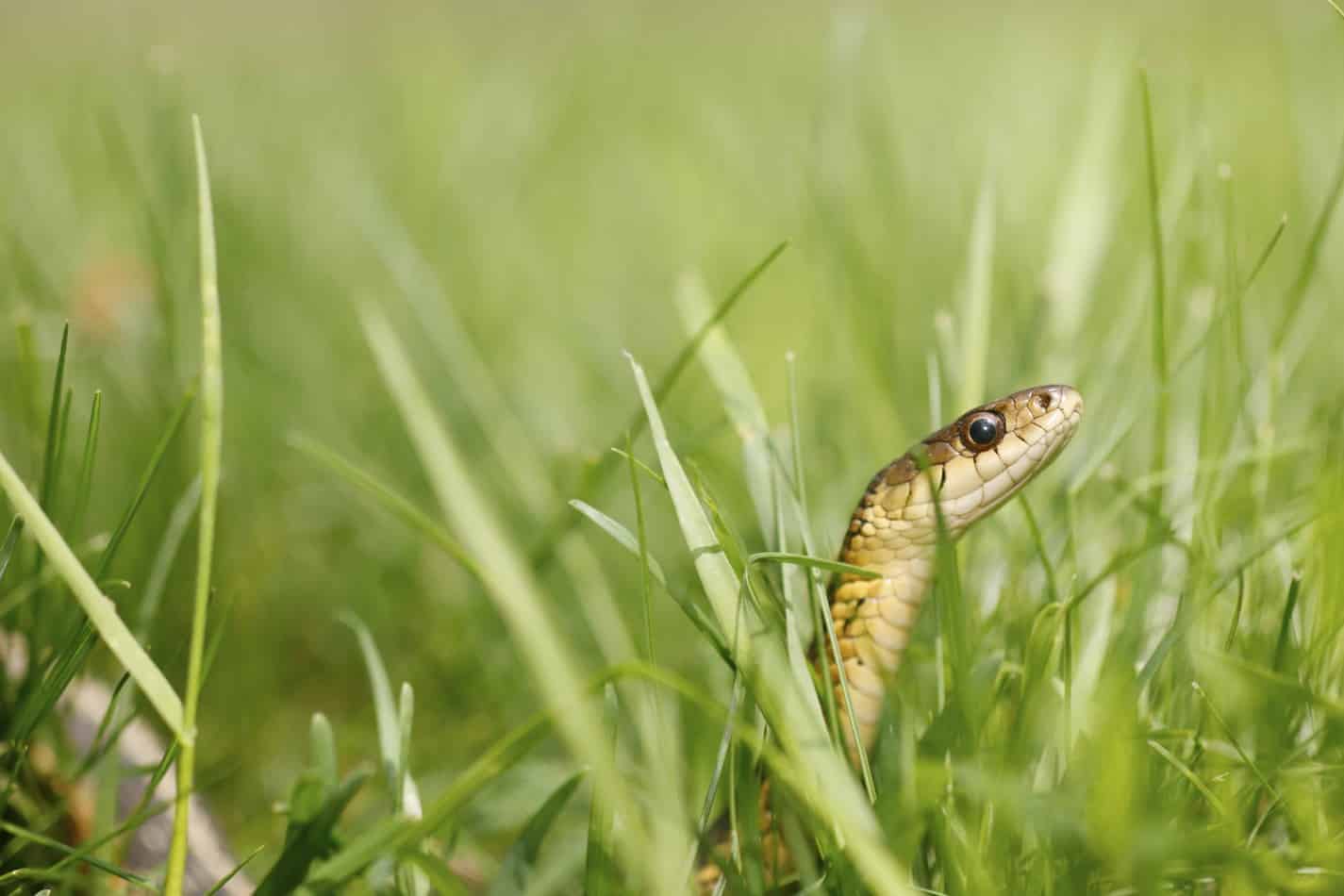
Garter snakes are a rather diverse group of snakes. This diversity has led them to spread out and adapt over a fair stretch of land.
While they mainly encompass North America, they have no specific natural environment in that region that they tend to live in. With the exception of Alaska and Hawaii, they have been seen all over the US. They do not need a specific climate to survive.
That doesn’t mean there aren’t variances within the species though. Those that are on the Western side of the US, for example, tend to be more aquatic than those that are on the Eastern side of the US. Garter snakes have been known to live in forests, woodlands, fields, grasslands, and lawns.
Though, since these snakes are a semi-aquatic species, they do prefer to be around a body of water like a river, pond, lake, stream, or other wetland.
Also, because of the many places they can live, don’t be surprised to find one hiding in your garden or yard. They like
Garter snakes are able to live in all of these environments because they have adapted to each of them. Their diets are able to sustain them off of almost anything in a location. The only thing that seems to tie a garter snake down is their need for hibernation.
Since garter snakes, like all snakes, are cold-blooded, they need to go through this sort of hibernation called brumation. Certain snakes such as the garter snake and the rattlesnake collect themselves into a large mass of snake in order to keep themselves warm through the winter. Their collective body heat keeps the whole group warm and safe through the winter.
Typically, snakes are solitary creatures that don’t really get along when in close quarters. But the need for brumation changes this temporarily. Survival is more important than staying solitary after all.
Garter Snake Hunting Habits
Some snakes are known to have several advanced or new senses when compared to us humans, however, the garter snake doesn’t have too many of these advanced senses. The lack of specialized senses may be another reason that garter snakes are considered more harmless than other snakes.
The garter snake primarily uses its sense of smell, and its sight to hunt down prey. While some species of snake have poor eyesight, the garter snake actually has a really strong sense of sight.
However, the garter snake does not have the ability to sense heat like the vipers and boas have developed. Like most snakes, though, garter snakes are able to pick up on chemical trails with their tongue. This is used both in hunting and finding a partner when looking to mate.
The main strategy of the garter snake is to eat their prey
As such, the garter snake uses its stealthy slithering body as an advantage as it approaches its prey and then will attempt to eat the creature whole.
If the creature is able to resist and fight back, then the garter snake has been seen to use constriction to kill the creature first, but it is rarely necessary so long as they are able to successfully sneak up on their prey.
The Venomous Bite
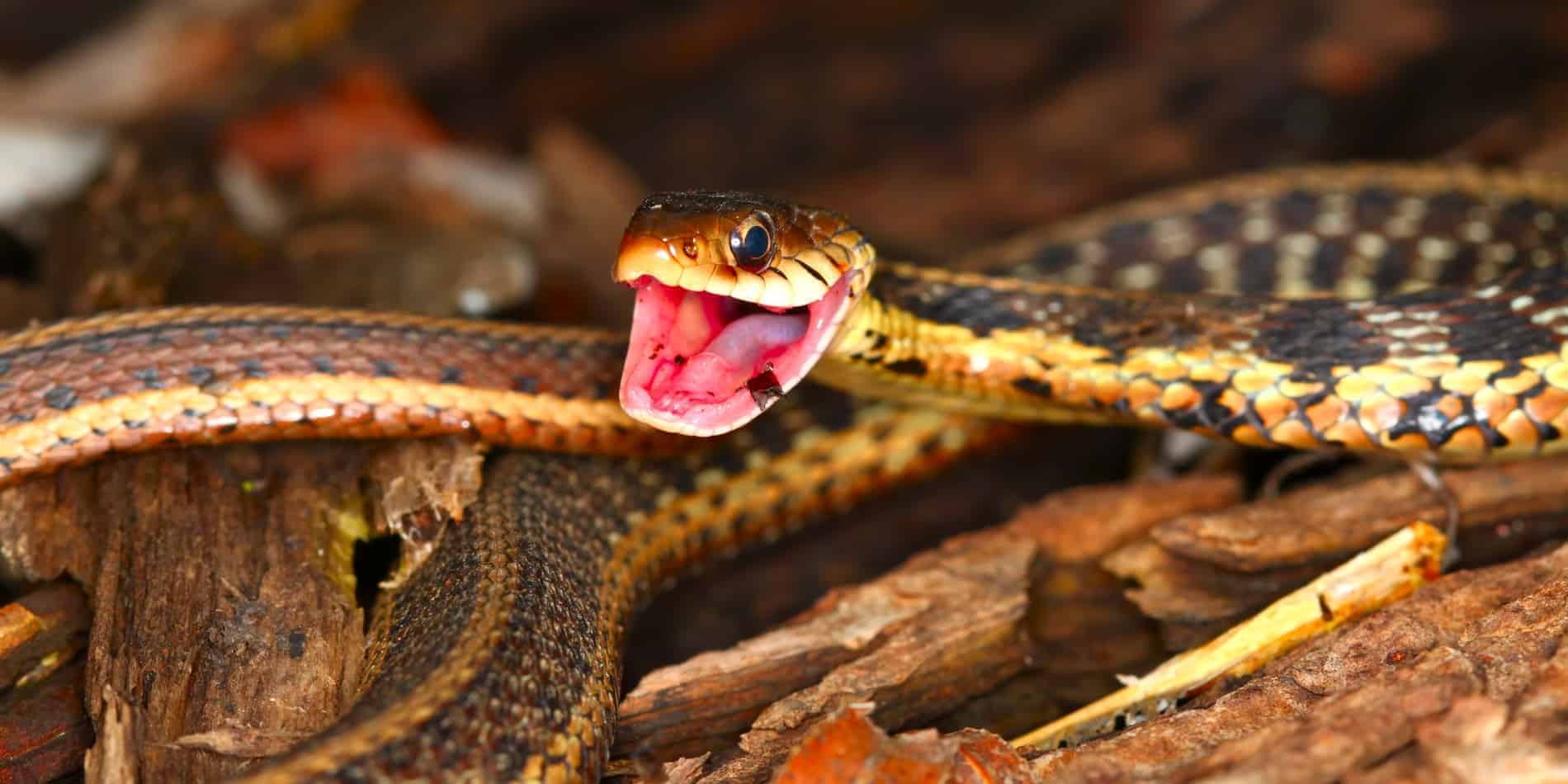
One of the more recent discoveries about the garter snake has been the fact that it is venomous. It was not believed to be so for some time, but recent discoveries have shown that the garter snake has a relatively weak neurotoxin that it can release when it bites.
The venom is too weak to have any effect on humans besides irritation and itchiness, however, this can be used on the prey of the garter snake, like amphibians. Frogs would stand no chance against this venom.
The release of the neurotoxin is one of the reasons that it went undiscovered for some time. Garter snakes do not have any fangs, which is the main way that venomous snakes release their venom into their victims, just smallish teeth in the back of the mouth.
As such, the way that the garter snake releases their venom is through chewing. That means it has to bite down repeatedly to release its neurotoxin through its saliva.
Besides how disgusting this is, it is a very ineffective and slow acting process which has led to the garter snake not using this approach to attempt advancing its hunting efforts.
Garter Snake Diet
The diet of the garter snake is diverse. In the most simple sense, garter snake will eat anything that they can, but they are limited by their small size.
All snakes are capable of eating anything that can fit inside the largest part of its body. Sometimes they will eat something even large than this, though this can sometimes cause digestion problems if it is too big.
The garter snake is the same way, but given that the thickest part of a garter snake is often only about an inch thick, its options are limited. Given this limitation, the snakes cannot be picky anything that can fit inside their mouth. This generally something that they will have to make adjustments for in their diet.
The list of acceptable food includes slugs, earthworms, leeches, lizards, frogs, tadpoles, ants, frog eggs, toads, crickets, mice, and other rodents. It goes on, but you generally get the point.
If it’s small enough to fit inside the garter snake’s body and weak enough for the garter to overpower, then it’s a potential meal for the garter snake. Luckily for the garter snake, very few of these creatures would be able to fight back much, so it has its pick of prey.
Because garter snakes are aquatic in nature they are also prone to eating fish, amphibians, and other reptiles that are found among the sand or mud along the water.
Very few snakes eat fish, which means less competition in the food chain. Garter snakes don’t even have much competition from humans in this case. Any fish the garter snake could eat would be too small for human consumption.
Read this article we recently wrote to learn more about what garter snakes like to eat, as well as learn how to properly and successfully feed a garter snake.
Garter Snake Reproduction

Mating for garter snakes takes place right after they have gone through their form of hibernation or brumation. This leads to troves of garter snakes being in the same area which is super convenient because they don’t have to go searching in the wilderness to find each other instead.
At the end of brumation, the female garter snake releases a pheromone which specifically sends out the message that she is fertile and wants to mate. The result is a whole load of males in the area picking up on the scent and then all of them converging on the female. This can include up to 25 male snakes. This pool of mating snakes has been called a mating ball.
Some male snakes will release the same mating based pheromone to attract other males to them. They do this in order to steal the body heat of the other snakes that think they are mating with a female. They will leave as soon as they are warmed up and often head off to the nearest female that is releasing pheromones, but now they are warm and able to continue mating for a long while.
This act of stealing heat is called
Given that mating happens right around the brumation period, this is an amazingly effective tool for the males that use it, and may be the reason why females try to mate during this time period as ultimately they are warmed up by the process too.
Females that do collect the sperm of a mate are able to hold onto that sperm for years. It doesn’t die out during this time.
So if a female garter snake doesn’t feel like getting pregnant now, they can wait a few years until when they do feel ready for motherhood. No need to rush things, right? Not that they are signing on for a big commitment as a parent though.
Motherhood for a snake isn’t much as, since garter snakes do not care for their young, motherhood is only pregnancy. Garter snakes are ovoviviparous which means they lay their eggs inside their body and then produce their young live.
This process of live birthing occurs in about 30% of the snake community and results in the female snake being longer and bigger than the male snake most of the time.
A female will lay anywhere from 20 to 40 babies on an average, though the lowest reported babies have been 3 and the highest has been 101. That’s a pretty big range.
Naturally, since they don’t have to take care of their young, there isn’t too much of an issue with the number of babies that they have so long as they have the energy to keep up with the pregnancy process.
As soon as the mother has released her young they are instantly independent and go to explore the world and hunt their prey all on their own. Good thing too.
Snakes don’t have the best record for being great mothers and this is why. Luckily, garter snakes don’t just lay their eggs and ditch them like the majority of snakes. Not that they have a lot of choice in the matter.
Garter Snakes as Pets
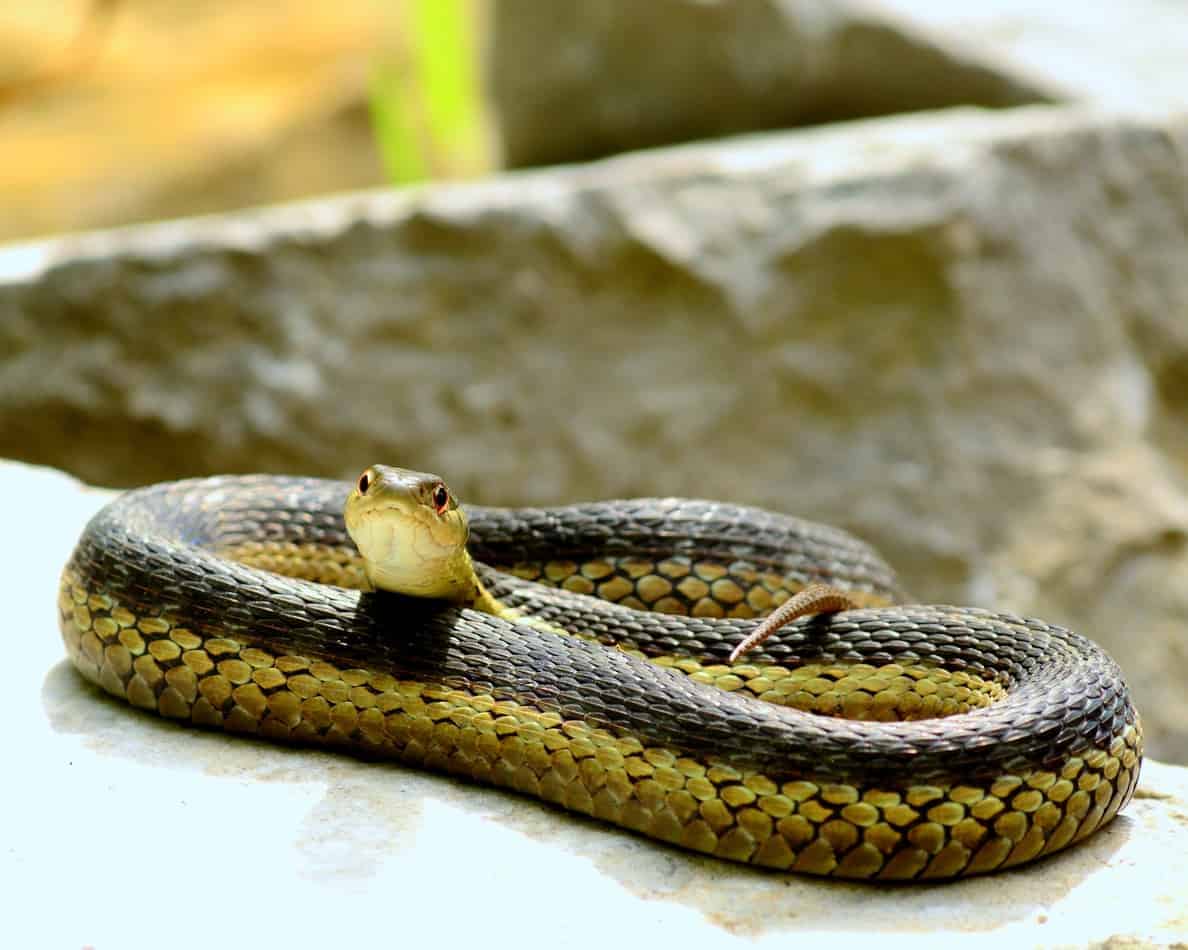
Given the commonality and the availability of garter snakes, they are often kept in captivity to serve as pets.
They are quick to adapt to their surroundings and easy to care for, so they do make good pets. However, there are a couple of things that you will want to have prepared before you take steps to have a garter snake as a pet.
The first thing you will need to know is that these snakes are friendly, or rather, they are not aggressive, as it is hard to say if a snake is ever truly friendly.
They don’t exactly have feelings after all. So take care as you play with it the first couple of days. Allow for it to slither through your fingers and up and down your body so that it is used to you as its owner and it won’t be too scared of you.
Adjustment time is important for the comfort and health of a snake. You and the garter snake will be happier if you allow for this short time period.
The big reason you don’t want to scare the snake is that when garter snakes are scared, they will release a stinky liquid that is supposed to scare off predators.
The garter snake’s theory is that “if my predators think I smell bad they’ll think I’ll taste bad.” Unfortunately, though you are not a predator, you can seem like one. So if you scare it, it will remind you why you shouldn’t.
As for the care of a garter snake, you will want to have a range of temperatures within the terrarium of your pet. For this, you’ll first need a terrarium which is just a ten gallon or more tank that will house the snake.
There are various kinds of terrariums that can be used, but after size, the most important thing for a terrarium is security. Snakes like to escape if they can. For terrarium recommendations, check this article.
You’ll want to get some form of bedding. This can be as official as pet store snake bedding or as simple as shredded newspaper. Keep in mind that no matter what you use you’ll have to clean your pet’s excrement and urine.
So choosing around which is easiest to clean may be a wise choice. If you do decide you want to use something other than newspaper, you can find some possibilities here.
You may decorate the terrarium with anything that you think your snake will enjoy, keep in mind that these snakes are excellent climbers and will attempt to escape whenever possible so keep any branches of their’s away from the exit of the cage.
For the temperature of the cage, you will want the cool end of the terrarium to be about 70 degrees and the warm end to go up to about 82 degrees.
You can achieve this through a large rock to provide a nice
Since garter snakes are aquatic in nature they like water. So you’ll want to have a water dish inside their terrarium for them. Snakes like to hang out in the water, so make sure it isn’t too deep so the snake doesn’t drown. Being semi-aquatic, a garter snake might be able to have a deeper dish than some snakes, but ideally, you’ll keep the water fairly shallow.
It is also important to keep the water clean. Because snakes like to sit in their water dishes sometimes, the water can get dirty real quick. But the water is also for drinking, not just swimming. If it isn’t cleaned quickly, the snake could get sick. The sooner it’s cleaned, the better.
Garter snakes are a great option as a pet they are really low maintenance and are not aggressive or deadly to their owners.
Because they are not deadly there are a few things you will want to be careful of avoiding, such as their stinking musk if they feel threatened, but generally, you will be able to support your reptilian friend with little cause for alarm and at a low cost too.
Here, you can read an article we recently wrote that talks more about garter snakes as pets, including what their terrarium should look like, and what the best way to get a garter snake is.
Related Questions
Do garter snakes attack humans? Like all animals, if the garter snake is threatened than it will attack whatever is threatening it.
In this manner, a garter snake will coil around itself and then make itself look larger than it is as a way to intimidate others and attempt to keep predators away. It will bite anything that continues to threaten it at this point, but the worst that will happen from that is some drawn blood, as there is nothing in the garter snake that is all that threatening to a human.
So while not pleasant when they do attack, it is not something you should be overly concerned about.
How long can a garter snake get? While the average length of a garter snake is from 23 to 30 inches the longest recorded garter snake has been 5 feet long. So while not likely these snakes can get above 4 feet in length.
How long can a garter snake go without eating? This question is dependent on the situation the snake is in. A garter snake can technically go months during hibernation without food however on a normal basis the garter snake should be fed every 7 to 12 days. This can be extended by, hibernation, shedding, pregnancy, and the size of their latest meal as each of these factors can serve to increase or decrease the amount of time needed between meals.

